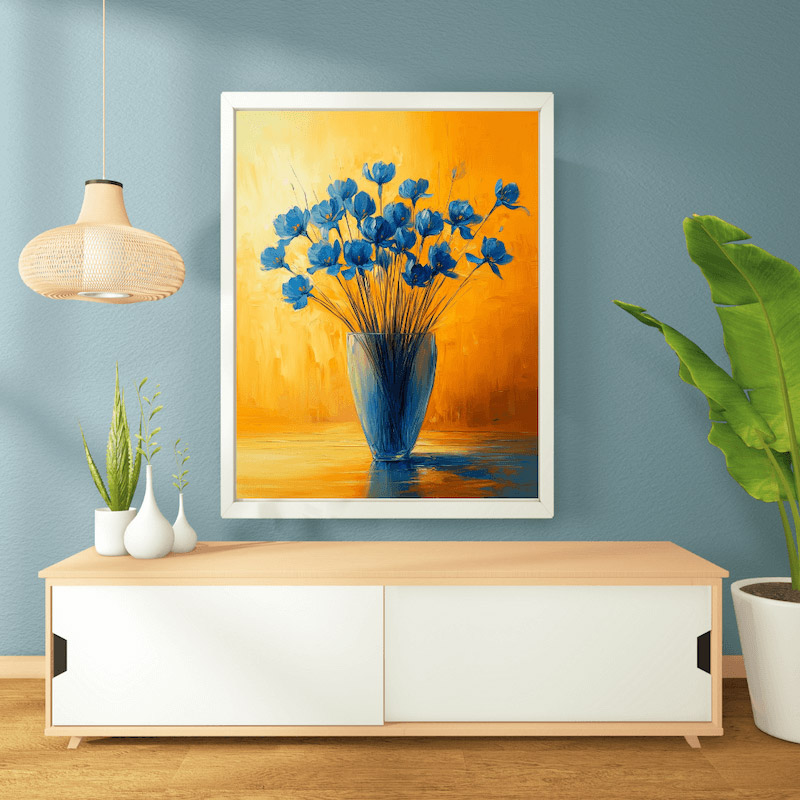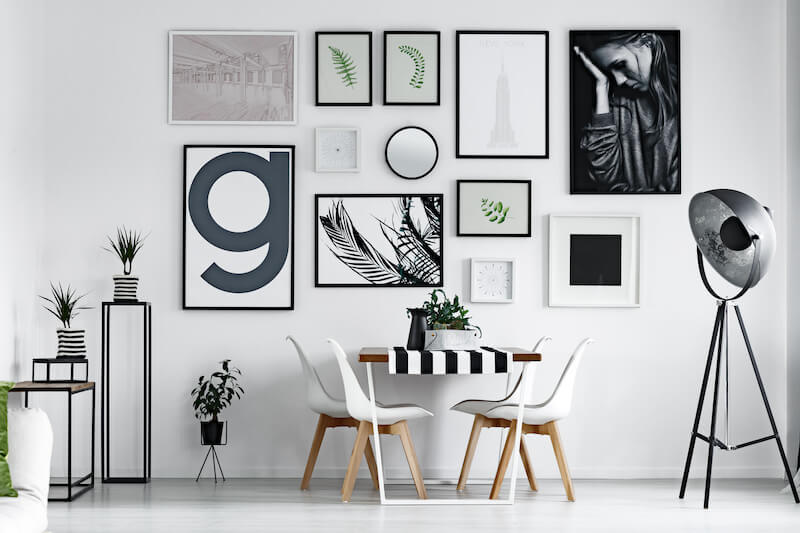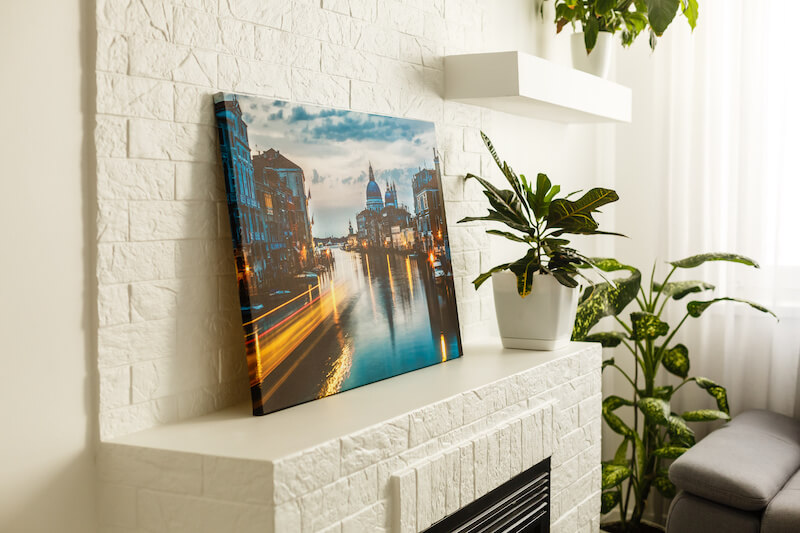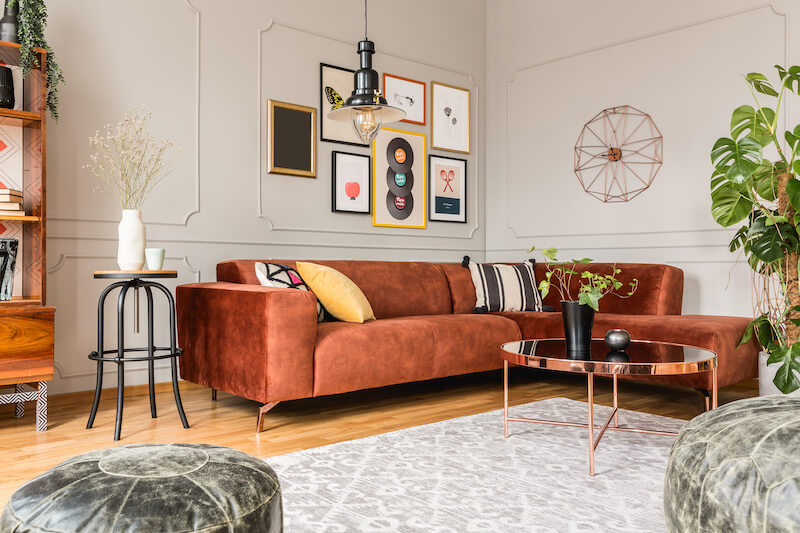Choosing wall art can be both exciting and a little daunting, with so many details to consider. From the lighting and the space you’re working with to budget and personal style, each piece of wall art shapes the feel of a room. With some careful thought, you can use wall art to decorate your home in a way that reflects your personality while appearing cohesive and inviting. So, how do you balance aesthetics and practicality when picking wall art? Here are some things to keep in mind:
Wall Art Selection Cheat Sheet
- Direct lighting can cause damage to some art, particularly paper-based art like prints, watercolors, and photos.
- Protective covers can cause glare, so check angles with something reflective if you’re planning on buying framed art.
- Measure your space before you start looking for wall art.
- Big framed art is heavy. Check for wall studs to determine where you can hang it.
- Scale and orient the art to suit the wall size. For planning purposes, a gallery wall of small pieces can be treated the same as a single large piece.
- Looking for big art on a budget? Stretched canvas prints are more affordable, weigh less, and are easier to handle; plus, they don’t need frames.
- A working knowledge of color theory can help you choose wall art, whether you want it to mesh with your decor or provide a point of contrast.
- If you’re putting art on more than one wall, don’t choose the same type of art. Introduce variety, such as a big piece on one wall and a small gallery on another.
Consider Your Lighting

Lighting is crucial when picking wall art. Direct sunlight, for example, can damage some types of art, so think about how light enters the room and where it might fall on your pieces. If your art will have a protective cover, such as glass or acrylic, glare is also a concern.
Figure out where you will be sitting or standing in the room most of the time, and use a mirror or something else reflective to check if the angle will work. Low-glare glass is available, but not always a perfect solution. In darker rooms, you might want to add accent lighting to highlight your artwork properly.
Measure Your Space
Measure the space where you plan to hang your art to ensure it fits just right. This step will help you avoid buying something too large or too small. A good rule of thumb is to hang art at least 6 to 10 inches above furniture for a visually pleasing look. Leaving this amount of negative space on all sides of the wall art (or gallery, if using multiple pieces) is generally a good idea.
If you’re not sure how big you want your art, use painter’s tape to mark off a potential size and leave it up for a day or two to get a feel for it. (This is also a good way to try out potential gallery configurations before seeking out pieces to fit.) If you’re stuck between two sizes, take pictures with each tape outline to compare.
Choose Your Scale

After measuring, consider the scale. If you have a large wall, you might want one big, impactful piece—or you might want several smaller pieces to create a gallery wall. When it comes to hanging canvas on the wall, you also need to be mindful of the weight. Large, framed pieces may require mounting on wall studs, while unframed canvases are often lighter and easier to install.
Decide on a Budget
Consider your budget when choosing art that fits your desired size requirements. Stretched canvas prints, for example, are usually more affordable than framed works of the same size. Originals (and reproductions that use paint) are more expensive, though the texture, value, and exclusivity appeal to many.
If you’re looking for a budget-friendly option, prints or smaller studies can be great choices. While smaller art pieces are generally cheaper than larger art, making a gallery wall with multiple frames can add up.
Framed or Unframed?

Framed art gives a room a more traditional, polished look, while unframed art feels casual and modern. For an eclectic vibe, consider mixing both framed and unframed pieces.
You can even use floater frames on stretched canvases for a different look that’s both polished and contemporary. Floater frames give a “finishing touch” while leaving a small gap between the canvas and the frame, adding depth and dimension. This mix can bring dynamic energy to your decor.
Choose Your Color Palette
Once you know the size and type of art you’re looking for, you’re ready to start looking at actual images. Think about your overall color scheme before choosing art. The colors should ideally work with your decor, either by matching the dominant color themes or adding a striking contrast.
If you’re opting for framed art, consider how the frame color complements both the art and the room’s color scheme. You should also consider the frame’s material. Don’t be afraid to mix and match; even mismatched wood colors can look good when done intentionally.
Create Variety on Different Walls

To create a cozy, visually interesting space, mix things up on different walls. Hanging a large piece on every wall, for example, might feel museum-like rather than homey. You could have a big piece as a focal point on one wall and a collection of smaller pieces on another.
Diptychs or triptychs—those pieces of art that come in sets of two or three (or more), creating a greater whole—are also great for adding variety. You could even have three-dimensional sculptural or architectural pieces. Consider the following wall art ideas for inspiration:
- A single large piece
- A diptych or triptych
- A grid of several small pieces
- A gallery wall with a variety of sizes
- A mirror
- Framed pieces set on furniture and leaning against the wall
- An ornamental clock
- Decorative wall sconces
- Floating shelves filled with knick-knacks
Each of these options can be oriented horizontally or vertically, increasing your options even more.
Does it Look Good to You?
In the end, the most important thing in choosing wall art for your personal space is whether the art makes you happy. Unless you’re choosing wall art to stage your home, your personal style and what resonates with you should be the final word. Let your space reflect your personality by picking pieces that make you feel good.
The Finishing Touches for Your Home
Choosing wall art involves balancing practical details like lighting, space, and budget with your style and taste. By thoughtfully considering each element and taking inspiration from recent art trends, you can create a room that feels uniquely yours. Trust your instincts and choose art that brings you joy—it’s the perfect finishing touch for a welcoming, stylish home.




